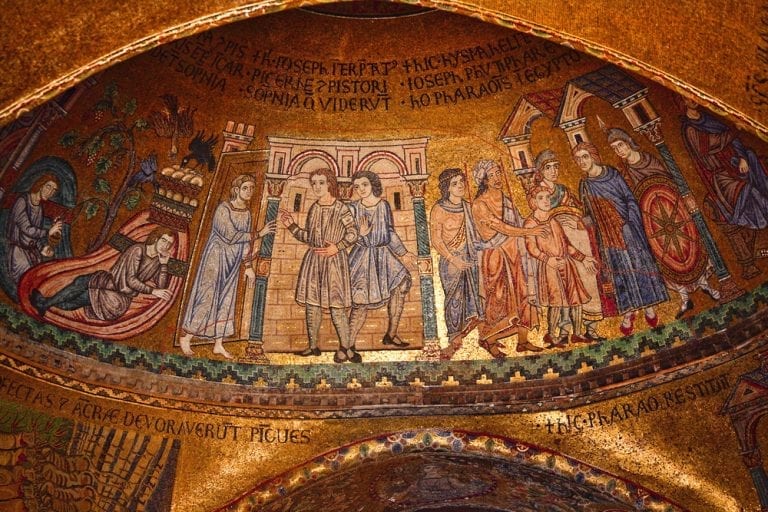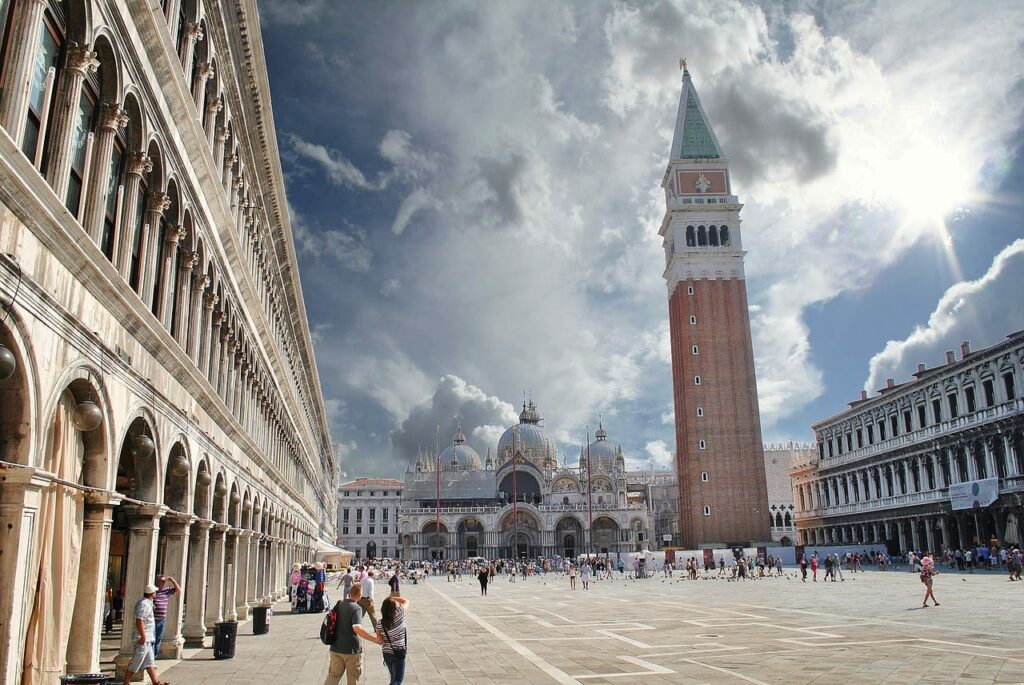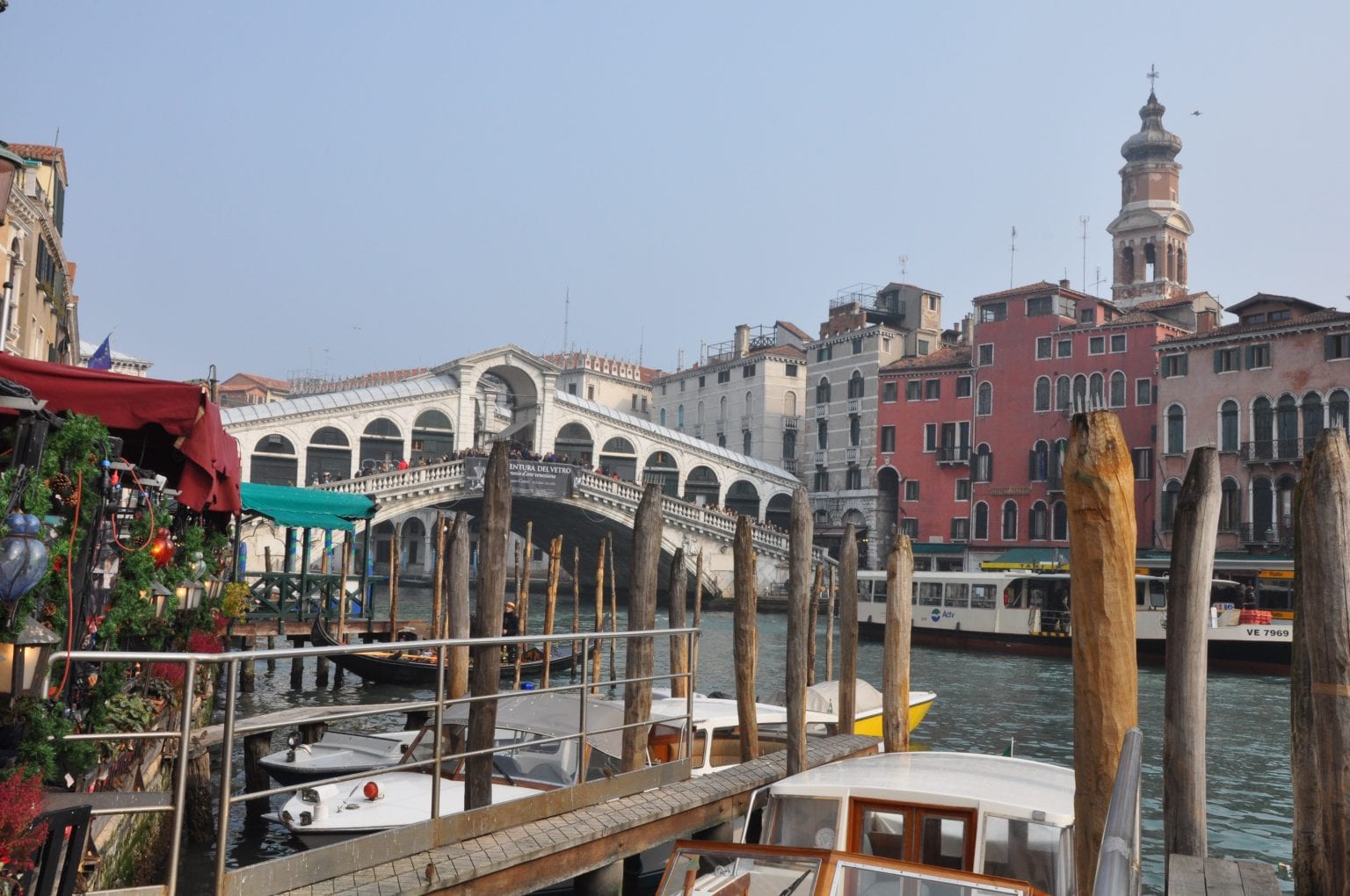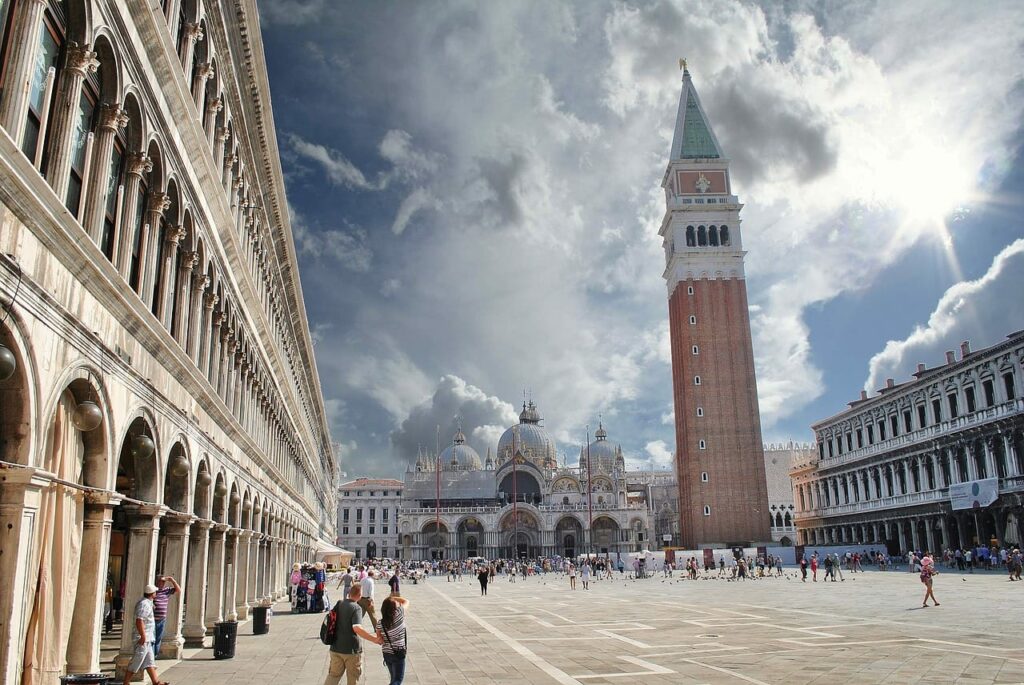Continuar a explorar
Veneza, Itália
Veneza Essencial
Explorar mais
A Basílica de São Marcos é um dos pontos turísticos mais visitados em Veneza, e um ponto de passagem obrigatório no itinerário de qualquer viajante em Itália! Mas com uma história que se estende até ao século IX d.C., é também uma igreja com muitas histórias e lendas interessantes por detrás dela. Aqui estão seis dos factos mais fascinantes sobre a Basílica de S. Marcos!
1 A basílica começou com um conto de swashbuckling sobre o rapto
 O primeiro Basílica de St. Mark foi construído neste local no século IX para albergar relíquias muito sagradas - relíquias que tinham sido roubadas! Em 828, mercadores de Veneza roubaram o corpo de São Marcos Evangelista, um dos quatro Apóstolos, de Alexandria, Egipto. De acordo com a lenda, eles escaparam aos guardas (muçulmanos) escondendo-os debaixo de camadas de carne de porco em barris!
O primeiro Basílica de St. Mark foi construído neste local no século IX para albergar relíquias muito sagradas - relíquias que tinham sido roubadas! Em 828, mercadores de Veneza roubaram o corpo de São Marcos Evangelista, um dos quatro Apóstolos, de Alexandria, Egipto. De acordo com a lenda, eles escaparam aos guardas (muçulmanos) escondendo-os debaixo de camadas de carne de porco em barris!
Enquanto no mar, uma tempestade quase afogou os graverobbers e a sua preciosa carga, diz-se que o próprio São Marcos apareceu ao capitão e disse-lhe para baixar as velas. O navio foi salvo, e os mercadores disseram que deviam a sua segurança ao milagre.
Toda a história é retratada no mosaico do século XIII por cima da porta esquerda ao entrar na basílica.
2 Há mosaico suficiente para cobrir 1,5 campos de futebol americano!
There are more than 85,000 square feet (or 8,000 square meters) of mosaic in St. Mark’s Basilica… or enough mosaic to cover over 1.5 American football fields! The mosaics were done over 8 centuries, mostly in gold, and the result is astonishing. Enter the basilica at different times of day to see how the light makes the colors and scenes, look different.


3 Existem mais de 500 colunas
Apenas mais um exemplo do tamanho e da quantidade de coisas espantosas na Basílica de St. Mark é o número de colunas. Existem mais de 500 colunas e capitais na basílica, e a maioria são bizantinas, datando entre os séculos VI e XI. Algumas capitéis clássicas do século III também estão misturadas!

4 Muitos dos tesouros da basílica vieram das Cruzadas & de Constantinopla
A Quarta Cruzada, em particular, deu à Basílica de S. Marcos um inesperado golpe de sorte. Afinal, esta foi a Cruzada que terminou, em 1204, com a conquista de Constantinopla (Istambul dos tempos modernos).
The result? A lot of treasure was shipped to Venice, and installed in St. Mark’s Basilica — including the four bronze horses, an icon of the Madonna Nicopeia, enamels of the Golden Altar-piece, relics, crosses, chalices, and patens!

5 O Palácio d'Oro envergonha as Jóias da Coroa
Esqueça as gemas cintilantes na Torre de Londres: A Família Real não tem nada na Basílica de St. Mark! O Pala d'Oro, um altar de ouro bizantino, está cravejado com centenas de pedras preciosas - literalmente. Incluem 1.300 pérolas, 300 esmeraldas, 300 safiras, 400 granadas, 100 ametistas, mais rubis e topázio.
6 Aquela torre sineira? Desabou uma vez

O campanário de 323 pés (98,6 metros) de São Marcos remonta ao século IX... mas teve de ser reconstruído em 1903. A razão? Desabou! Tinha sido retrabalhada no século XVI, e aparentemente não tão bem assim.
Desabou a 14 de Julho de 1902. (Para ser justo, tinha sobrevivido a vários terramotos antes disso!). Embora tenha enterrado a varanda da Basílica nos escombros, felizmente, a própria igreja foi salva. Mas o incidente já era suficientemente embaraçoso!
De 1903 a 1912, a torre sineira foi reconstruída exactamente como tinha sido... excepto com técnicas melhores e mais seguras.
Ok, mencionámos seis, mas uma vez que estamos num rolo, aqui estão mais fascinantes os nossos conhecimentos:
- As peças de ouro dos mosaicos dentro da Basílica de São Marcos são feitas com ouro REAL!
Venice was in the past a very wealthy city of merchants: what the Republic lacked in military strength or in land domination, it had in riches. The basilica’s mosaics are not just a way to please God and St. Mark or to communicate complex religious concepts, they were also a way to show the wealth of the city to important guests, like kings or ambassadors from other countries.
As peças douradas são na realidade feitas de ouro: cada uma tem uma folha fina de ouro "ensanduichada" entre duas camadas de vidro transparente. Com uma tal exibição de material precioso, os venezianos poderiam mostrar ao mesmo tempo a sua grande devoção mas também o seu "peso" político: uma coisa extremamente importante para um país tão pequeno.
- As grandes cúpulas exteriores acima da basílica são realmente falsas!
In Venice, it’s impossible to build huge structures: the terrain is frail, so you have to carefully stick to small, light and flexible buildings. But the Venetians had to find a way to astonish their guests: so they optimized some very clever tricks to cheat the eye and give everyone the impression that the buildings are huge and imposing.
In St. Mark’s Basilica, there is a great example of this: the five big domes that give the building its distinctive shape are just a superstructure made of wood covered with a thin layer of lead. They are actually completely empty: the brick-built domes with the mosaics that you see inside the church are much lower.
We can arguably say that the only role of those big empty domes is to make the building look much bigger than it really is: this way the ships approaching the city could recognize its shape from afar, and be even more astonished by the legendary city rising from the waters.
- Em 2019, um grande "acqua alta" inundou completamente a igreja!
In the Venetian Lagoon, there are tides: sometimes these tides go higher than normal and as a result, some parts of the city get flooded. St. Mark’s Square is the lowest part of the city, so it’s pretty common to see its floor partially or totally submerged in water.
But on November 12, 2019, things went completely out of control: the tide rose so high that it reached the second-highest level ever recorded in the history of the city. The custodians of the church were unprepared for this event: the water not only flooded the antechamber of the basilica, which is at the same level as the square but also the church itself, which is much higher.
The damage was substantial and the building is still recovering: at least this tragic event gave a big push to the completion of the MOSE project, a system of mobile barriers meant to protect the Lagoon from the most dangerous tides. The barriers were tested a couple of times in 2020 and apparently, they worked fine: we all hope they will be able to protect the basilica in the future.
- A Basílica de St. Mark não é a mais antiga, nem a maior igreja de Veneza!
The St. Mark’s Basilica was built starting from the IX century: but the history of Venice starts way before that moment, in the V-VI century. So there are churches around the city that predate the most important monument: according to historians, the oldest holy building of the city could be the church of San Giacometto, very close to the Rialto bridge. The Rialto area was, in fact, the first spot that was colonized when the islands started to be populated: the city of Venice was actually called “Rialto” for the first centuries.
Despite its enormous size, at least in proportion with the other buildings of the city, St. Mark’s Basilica is also not the biggest church: this title goes to the church of Santi Giovanni e Paolo, home to the very powerful Dominican monastic order. Their monastery was so big that when Napoleon conquered Venice he chose that building to become the first big public hospital in the city: and the hospital is there still today! You can learn more about San Giacometto and Santi Giovanni e Paolo if you take the Welcome to Venice tour or the Venice in a Day tour, which both feature these very important churches!

Special thanks go to our Walks of Italy guide Mosè Viero for sharing these additional interesting facts about St. Mark’s Basilica.
Se quiser saber mais, veja as nossas experiências em Veneza, tanto na Basílica de São Marcos como no Palácio dos Doges - ou, para uma visita realmente VIP, aceda à Basílica de São Marcos depois de horas, quando está fechada ao público!
Continuar a explorar
Veneza, Itália
Veneza Essencial
Explorar mais


